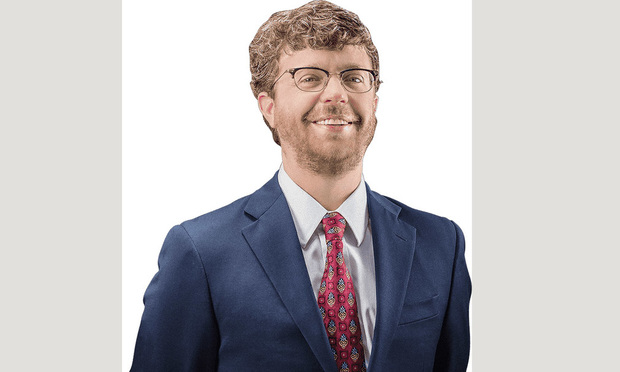When Asbestos Exposure and COVID-19 Intersect
There is relatively little information on the intersection of asbestos exposure and COVID-19 infection, despite the clear connection in risk factors.
May 20, 2020 at 07:09 PM
6 minute read
 Kevin McKie is an attorney at the Environmental Litigation Group and a partner with the Law Center.
Kevin McKie is an attorney at the Environmental Litigation Group and a partner with the Law Center.
The list of individuals who are especially at risk regarding COVID-19 infection is oft-cited in the media and well-known to many. Some common examples included on this list are the elderly, the immunocompromised and those with preexisting lung diseases. However, there is relatively little information on the intersection of asbestos exposure and COVID-19 infection, despite the clear connection in risk factors. For example, the Environmental Protection Agency (EPA) highlights lung cancer, mesothelioma and asbestosis as the three major health effects of asbestos exposure; all of which can be classified as preexisting lung diseases. Moreover, in 2017, the CDC reported that the number of mesothelioma related deaths increased from 1999 to 2015 with significant increases among persons aged 85 years and above. The latency period for asbestos exposure and the development of mesothelioma is 20 to 71 years. The CDC study indicates that many who were exposed to asbestos years ago are only now developing health effects.
Who Should Get Screened?
Due to the ubiquitous use of asbestos in the mid-20th century and the latency period for developing asbestos-related medical conditions, many are unsure if they should get screened for asbestos. However, certain occupations have been linked to higher levels of asbestos exposure due to the workplace environment and products being made. For example, researchers for the American Academy of Family Physicians noted key sources of asbestos exposure, indicating that some industrial workers and veterans may be at higher risk. These cases of occupational exposure occur from working with asbestos-containing products such as: flight materials, electrical products, shipping materials, brake linings, building materials and others. Although the EPA has reduced the number of asbestos containing products since the 1970s, many have been exposed prior to EPA regulation, while others are exposed through legacy uses. It is more likely that industrial workers and veterans have been exposed years ago because environments such as shipyards, steel mills and refineries are related to "past direct occupational exposures."
How COVID-19 Affects Screening
Industrial workers and veterans who were exposed to asbestos may be asymptomatic for decades because the asbestos dust remains in the lungs long after exposure and slowly causes damage. This lung damage can lead to diseases such as asbestosis, lung cancer, mesothelioma, COPD and pleural plaques. Therefore, the National Heart, Lung and Blood Institute recommends screening for asbestos because a doctor may be able to slow the disease, ease the symptoms, or prevent future complications. Unfortunately, the effects of the COVID-19 pandemic on the medical system have also affected the screening and treatment of asbestos-related diseases. Patients may be less likely to go to the hospital, while doctors may delay X-rays, chest CT scans, pulmonary function tests and other recommended diagnostic procedures. Similarly, people with prescribed treatment, such as chemotherapy or surgery, may experience delays or gaps in their treatment. According to a study done by the American Cancer Institute, 51% of the surveyed cancer patients reported COVID-19 related disruptions in their care.
How COVID-19 Affects Claims
The COVID-19 pandemic also affects toxic tort claims for occupational exposure to asbestos. For example, in Handling Toxic Tort Litigation, 57 Am. Jur. Trials 395 § 83 (2020), Mark S. Dennison and Warren Freedman state that an essential element in toxic tort litigation is that the plaintiff had or does have an asbestos related illness, disease or condition. Therefore, despite the existence of asbestos trust funds for veterans and industrial works, the delays in screening and testing due to COVID-19 will prevent many from joining toxic torts suits. This problem is compounded by the shortage of personal protective equipment (PPE) that industrial workers need to reduce the risk of exposure. As states begin to reopen, the lack of PPE may increase the risk of future disease claims and medical monitoring damages. Medical-monitoring-based damages award compensation for future medical costs, while an increased risk of future disease claim is based on the emotional distress associated with the fear of a future disease. (Handling Toxic Tort Litigation, 57 Am. Jur. Trials 395 §§ 13, 31 (2020)). The pandemic's economic impacts may also affect latent asbestos claims, as an increasing number of businesses file for bankruptcy. For example, in In re Energy Future Holdings Corp, 949 F.3d 806 (3d Cir. 2020), the latent asbestos plaintiffs were barred from bringing their claim against a bankrupt business for failing to file before the "bar date." Although the case did provide some protective measures for latent asbestos claims, it is important to stay up-to-date on the financial status of defendants.
Getting Treatment Safely
Given the strain COVID-19 has put on our medical system and the higher risk of COVID-19 exposure, it is important to take all necessary precautions when getting treated for asbestos-related medical conditions. It is generally recommended to avoid in-person doctor visits to reduce COVID-19 exposure, but it is still possible to stay informed. The CDC recommends calling your doctor if you have concerns about a preexisting condition. Given the long latency period in developing asbestos related medical conditions, the doctor may be able to evaluate whether an in-person visit is necessary based on your symptoms, and knowledge of past asbestos exposure. For those currently undergoing treatment and in need of in-person treatment, follow CDC guidelines on how to reduce your risk of exposure and keep (at least) a two-week supply of needed medication. It is crucial for those with underlying medical conditions to sanitize their hands and surfaces often, wear masks and gloves, avoid touching faces and surfaces, and maintain at least six feet of space from others.
Kevin McKie is a lawyer at the Environmental Litigation Group, a partner of The Law Center.
This content has been archived. It is available through our partners, LexisNexis® and Bloomberg Law.
To view this content, please continue to their sites.
Not a Lexis Subscriber?
Subscribe Now
Not a Bloomberg Law Subscriber?
Subscribe Now
NOT FOR REPRINT
© 2025 ALM Global, LLC, All Rights Reserved. Request academic re-use from www.copyright.com. All other uses, submit a request to [email protected]. For more information visit Asset & Logo Licensing.
You Might Like
View All

Lawyers' Phones Are Ringing: What Should Employers Do If ICE Raids Their Business?
6 minute read

Read the Document: DOJ Releases Ex-Special Counsel's Report Explaining Trump Prosecutions
3 minute readTrending Stories
Who Got The Work
J. Brugh Lower of Gibbons has entered an appearance for industrial equipment supplier Devco Corporation in a pending trademark infringement lawsuit. The suit, accusing the defendant of selling knock-off Graco products, was filed Dec. 18 in New Jersey District Court by Rivkin Radler on behalf of Graco Inc. and Graco Minnesota. The case, assigned to U.S. District Judge Zahid N. Quraishi, is 3:24-cv-11294, Graco Inc. et al v. Devco Corporation.
Who Got The Work
Rebecca Maller-Stein and Kent A. Yalowitz of Arnold & Porter Kaye Scholer have entered their appearances for Hanaco Venture Capital and its executives, Lior Prosor and David Frankel, in a pending securities lawsuit. The action, filed on Dec. 24 in New York Southern District Court by Zell, Aron & Co. on behalf of Goldeneye Advisors, accuses the defendants of negligently and fraudulently managing the plaintiff's $1 million investment. The case, assigned to U.S. District Judge Vernon S. Broderick, is 1:24-cv-09918, Goldeneye Advisors, LLC v. Hanaco Venture Capital, Ltd. et al.
Who Got The Work
Attorneys from A&O Shearman has stepped in as defense counsel for Toronto-Dominion Bank and other defendants in a pending securities class action. The suit, filed Dec. 11 in New York Southern District Court by Bleichmar Fonti & Auld, accuses the defendants of concealing the bank's 'pervasive' deficiencies in regards to its compliance with the Bank Secrecy Act and the quality of its anti-money laundering controls. The case, assigned to U.S. District Judge Arun Subramanian, is 1:24-cv-09445, Gonzalez v. The Toronto-Dominion Bank et al.
Who Got The Work
Crown Castle International, a Pennsylvania company providing shared communications infrastructure, has turned to Luke D. Wolf of Gordon Rees Scully Mansukhani to fend off a pending breach-of-contract lawsuit. The court action, filed Nov. 25 in Michigan Eastern District Court by Hooper Hathaway PC on behalf of The Town Residences LLC, accuses Crown Castle of failing to transfer approximately $30,000 in utility payments from T-Mobile in breach of a roof-top lease and assignment agreement. The case, assigned to U.S. District Judge Susan K. Declercq, is 2:24-cv-13131, The Town Residences LLC v. T-Mobile US, Inc. et al.
Who Got The Work
Wilfred P. Coronato and Daniel M. Schwartz of McCarter & English have stepped in as defense counsel to Electrolux Home Products Inc. in a pending product liability lawsuit. The court action, filed Nov. 26 in New York Eastern District Court by Poulos Lopiccolo PC and Nagel Rice LLP on behalf of David Stern, alleges that the defendant's refrigerators’ drawers and shelving repeatedly break and fall apart within months after purchase. The case, assigned to U.S. District Judge Joan M. Azrack, is 2:24-cv-08204, Stern v. Electrolux Home Products, Inc.
Featured Firms
Law Offices of Gary Martin Hays & Associates, P.C.
(470) 294-1674
Law Offices of Mark E. Salomone
(857) 444-6468
Smith & Hassler
(713) 739-1250






